Side Menu:
Chief Purser Hugh McElroy
- 1911 Olympic
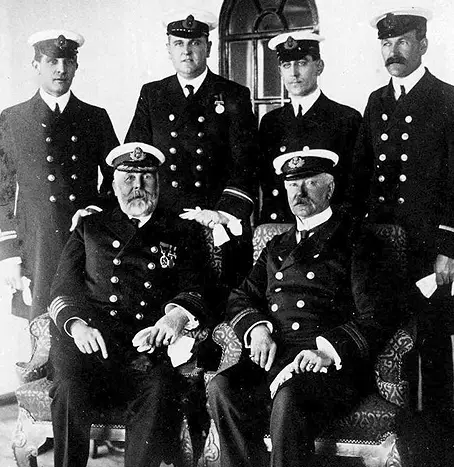
Hugh McElroy and the Olympic's officers. Standing: First Officer William Murdoch, Purser Hugh McElroy, Purser Claude Lancaster, 2nd Officer Robert Hume. Seated: Captain EJ Smith, Dr O’Loughlin. (Click to enlarge)
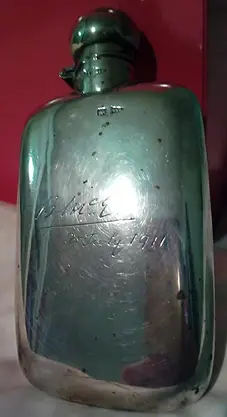
Hip flask with McElroy's signature
on it dated July 1911, while he was
aboard the Olympic. (Joan Obrien).
(Click image to enlarge)
In May 1911, McElroy followed Captain Edward Smith and First Officer William Murdoch as they moved over to join White Star's newest triumph - the RMS Olympic, at 45,000 tons. Intended to outclass the Cunard ships in luxury and size - if not in speed - Olympic needed the most experienced large-liner crew that the White Star Line could find. Captain Edward J. Smith assembled a crew that included Joseph Evans (later replaced by Henry Tingle Wilde) as Chief Officer, William Murdoch as First Officer, and Chief Purser Henry W. McElroy. On June 14th, 1911, Olympic made her maiden voyage to New York.
The size of the ship was impressive - beyond anything that McElroy had experienced before - 882ft long, 92ft wide and a height of 175ft, with 9 decks and a speed of 21 knots. At the time she was the largest ocean liner in the world, at 45,324 gross register tons, with a capacity for 2435 passengers and 950 crew. McElroy was seemingly overwhelmed by the size when interviewed by the press in New York. The Tacoma Daily Ledger (Tacoma, Washington) reported on the 30th June 1911 "Purser McElroy averred that the daily tour of inspection, which he made at 10:30am with Captain Smith, Dr O'Loughlin and Chief Stewart [sic] Latimer was fully nine miles. The captain computed the distance at one-third of that, while the surgeon insisted that it seemed like nine miles." (The Tacoma Daily Ledger, Tacoma, Washington, 30th Jun 1911)

McElroy and Olympic's officers. Standing: Standing: Purser Hugh McElroy
3rd Officer Henry O. Cater, 2nd Officer Robert Hume,
4th Officer David W. Alexander, 6th Officer Harold Holehouse.
Seated: 5th Officer Alphonse Martin Tulloch, Chief Officer Joseph Evans,
Captain Edward John Smith, and 1st Officer William McMaster Murdoch.
(Click image to enlarge)
On the Olympic, the Purser's Office was located on the C Deck landing of the Grand Staircase. First Class passengers could buy tickets for the various onboard amenities available to them, for example, tickets for the use of the Turkish Bath, Deck Chairs, and Swimming Bath cost $1.00 and tickets for the Squash Court and Gymnasium cost 50 cents. If passengers wanted to send a Marconi wireless message, that would be accomplished via the Purser's office, where the purser would write the message and send it up to the Marconi room on the boat deck.
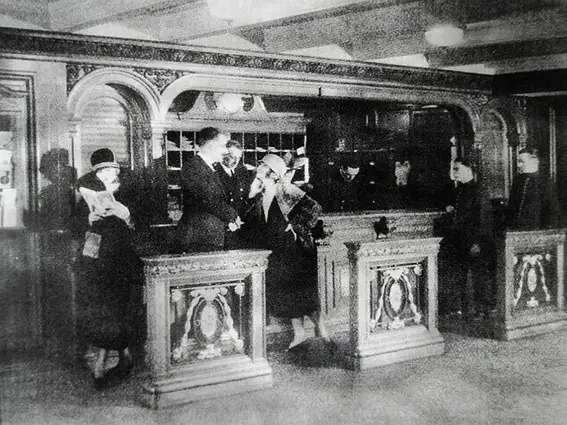
The First Class Purser's and Enquiry office on C deck aboard the Olympic.
(Click image to enlarge)
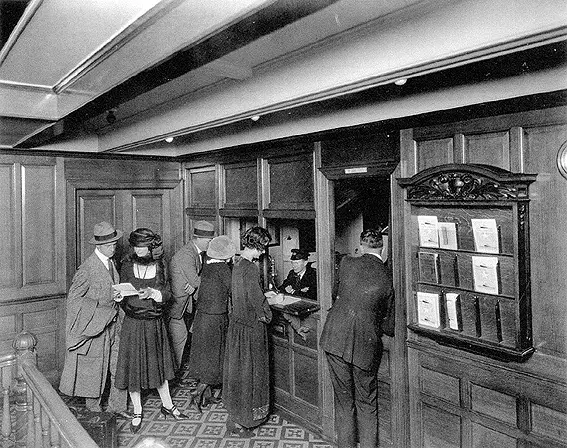
The Second Class Purser's office aboard the Olympic.
(Click image to enlarge)
During his time aboard the Olympic there are several photographs of him posing with fellow deck officers. His inclusion in these photographs confirms the importance of his role; arguably he was not only an officer (pursers were originally officers by definition) but the most important person aboard the ship, as it was his duty to pay the wages of everybody, including the captain.
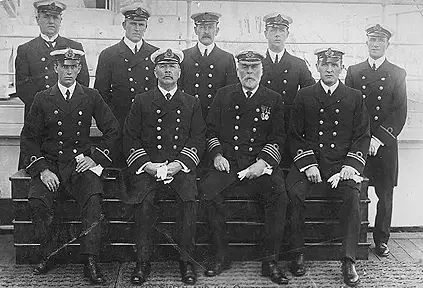
Olympic's officers (slightly different shot from above). Standing: Purser McElroy, Cater, Hume, Alexander, Holehouse. Seated: Tulloch, Evans, Captain Smith, Murdoch.
(Click image to enlarge)
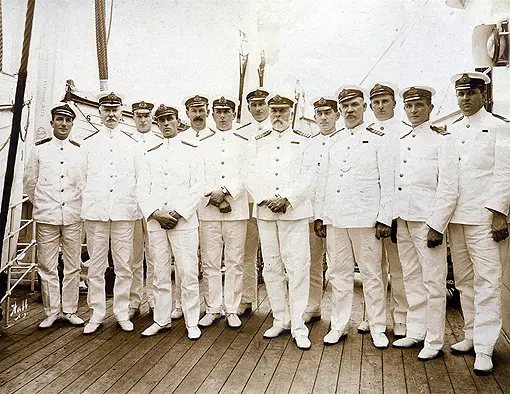
McElroy with the Olympic's officers in summer white uniforms.
(8.) (Click image to enlarge)
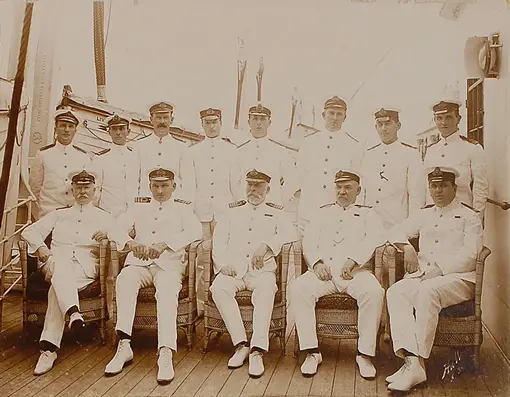
McElroy and his Olympic's officers seated in summer white uniforms, at lifeboat no.6. (8.) (Click image to enlarge)
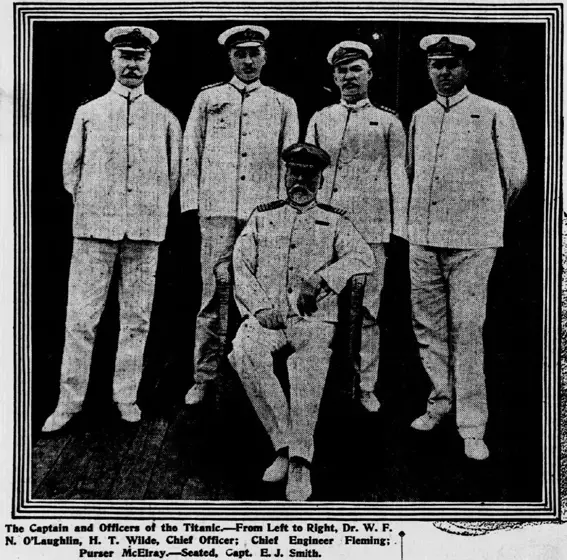
Another summer group photograph aboard the Olympic, courtesy of Kari Nejak-Bowen. (Click image to enlarge)
On the 20th of September 1911, on the Olympic's fifth voyage there was a collision between the Olympic and the British cruiser the HMS Hawke. While the HMS Hawke suffered severe damage to her bow and nearly capsized, the Olympic was able to return to Southampton under her own power; no one was seriously injured or killed. The voyage to New York had to be abandoned and the Olympic taken to Belfast for repairs, which took a good six weeks and also slightly delayed the construction of Titanic. It was not until December, 1911, that McElroy was able to rejoin his ship.
Hugh was clearly impressed with the ship enough to want to send a photograph of the Olympic to his new wife, along with a note:
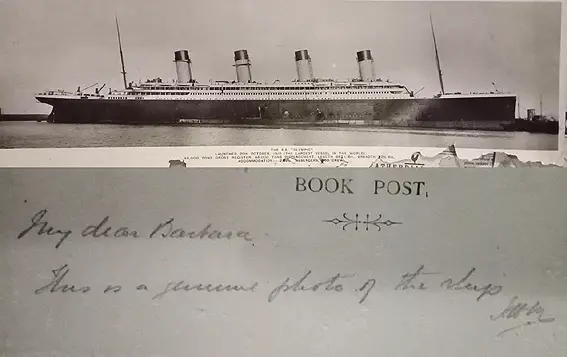
McElroy sent a photograph of the Olympic along with a note to his new wife Barbara. Courtesy of Joan O'Brien. (Click image to enlarge)